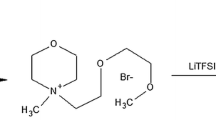Abstract
[EtNH3]+(NG −3 ) is generally considered as the first reported room temperature ionic liquid which was synthesized and characterized by Paul Walden in 1914. But the present investigation finds that [EtNH3]+(NG −3 ), a similar kind of ionic salt which is liquid at room temperature, was synthesized by Sir P C Rây three years earlier (in 1911) to Walden. Unfortunately, the latter work had not been paid any attention for more than a century because of unknown reasons. As per literature review, henceforth, Sir P C Rây and his coauthor (J N Rakshit) of that very particular synthesis of the ionic compound which was liquid at room temperature should be regarded as the discoverer of room temperature ionic liquid.
Similar content being viewed by others
Suggested Reading
C Wheeler, K N West, C L Liotta and C A Eckert, Ionic liquids as catalytic green solvents for nucleophilic displacement reactions, Chem Commun., p.887, 2001
M J Earle and K R Seddon, Ionic liquids: Green solvents for the future, ACS Symposium Series, p.10, 2002.
T Welton, Ionic liquids in green chemistry, Green Chem., Vol.13, p.225, 2011
A Reliman and X Zeng, Ionic liquids as green solvents and electrolytes for robust chemical sensor development, Acc Chem Res., Vol.45, p.1667, 2012.
S Patra and A Samanta, Microheterogeneity of some imidazolium ionic liquids as revealed by fluorescence correlation spectroscopy and lifetime studies, J Phys Chem B., Vol.116, p.12275, 2012
A Samanta, Dynamic stokes shift and excitation wavelength dependent fluorescence of dipolar molecules in room temperature ionic liquids, J Phys Chem B., Vol.110, p.13704, 2006.
M Watanabe, M L Thomas, S Zhang, K Ueno, T Yasuda and K Dokko, Application of ionic liquids to energy storage and conversion materials and devices, Chem Rev., Vol.117, p.7190, 2017.
S N Baker, T M McCleskey, S Pandey, G A Baker, Fluorescence studies of protein thermostability in ionic liquids, Chem Commun., p.940, 2004
A Chandran, D Ghoshdastidar and S Senapati, Groove binding mechanism of ionic liquids: A key factor in long-term stability of DNA in hydrated ionic liquids? J Am Chem Soc., Vol.134, p.20330, 2012.
V P Waiden, Ueber die Molekulargrösse und elektrisehe Leitfähigkeit einiger geschmolzenen salze, Bull Acad Imper Sci., (St Petersberg), Vol.8, p.405, 1914 (in Russian).
T Welton, Room temperature ionic liquids, solvents for synthesis and catalysis, Chem Rev., Vol.99, p.2071, 1999
(b)Ionic liquids: A brief history, Biophys Rev., 2018, https://doi.org/10.1007/s12551-018-0419-2
(c)Paul Walden (1863–1957): The man behind the Walden inversion, the Walden rule, the Gstwald-Walden-Bredig rule and ionic liquids, G Boeck, Chem Texts, 2019, https://doi.org/10.1007/s40828-019-0080-9.
W A Henderson, P Fylstra, H C D Long, P C Trulove and S Parsons, Crystal structure of the ionic liquids EtNH3NO3 — Insights into the thermal phase behaviour of protic ionic liquids, Phys Chem Chem Phys., Vol.14, p.16041, 2012
V N Emel’yanenko, G Boeck, S P Verevkin and R Ludwig, Volatile times for the very first ionic liquid: Understanding the vapor pressure and enthalpies of vaporization of ethyl ammonium nitrate, Chem Eur J., Vol.20, p.11640, 2014
J Claus, F G Sommer and U Kragl, Ionic liquids in biotechnology and beyond, Solid State Ionics, Vol.314, p.119, 2018.
P C Rây and J N Rakshit, Nitrites of the alkylammonium bases: Ethylammonium nitrite, dimethylammonium nitrite and trimethylammonium nitrite, J Chem. Soc., Trans., Vol.99, p.1470, 1911.
A G Morachevskii, Academicial Pavel Evanovich Walden (on 140th anniversary of his birthday), Russian J Appld Chem., Vol.76, p.1186, 2003.
A Chakravorty, The chemical researches of Acharya Prafulla Chandra Ray, Indian J Hist Sci., Vol.49.4, p.361, 2014.
P C Rây, On mercurous nitrite, J Asiatic Soc Bengal, Vol.65, p.1, 1896
P C Rây, Über merkuronitrit, Z Anorg Chem., Vol.12, p.365, 1896 (in German).
Noted in Nature, 54, 83, 1896.
R Dutta, S Kundu and N Sarkar, Ionic liquid-induced aggregate formation and their applications, Biophys Rev., 2018, https://doi.org/10.1007/s12551-018-0408-5
P C Rây and H K Sen, Tetramethylammonium hyponitrite and its decomposition by heat, J Chem. Soc Trans., Vol.99, p.1466, 1911.
Author information
Authors and Affiliations
Corresponding author
Additional information
Rajarshi Ghosh is associated with post graduation teaching and research in the Department of Chemistry, The University of Burdwan. His research interest covers synthetic coordination chemistry, bio inspired catalysis, biological inorganic chemistry, etc. Besides these, he is also interested in science popularization.
Rights and permissions
About this article
Cite this article
Ghosh, R. Discovery of Room Temperature Ionic Liquid. Reson 26, 241–244 (2021). https://doi.org/10.1007/s12045-021-1122-3
Published:
Issue Date:
DOI: https://doi.org/10.1007/s12045-021-1122-3




